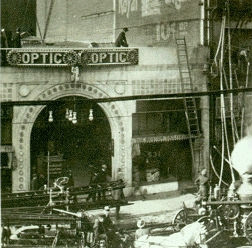Open All Night
In 1966 I was
one of three college-aged males in the USA who had not yet seen Steve McQueen
in The Cincinnati Kid. The other two were Munson and De Pento. We all considered ourselves movie buffs and
were surprised to discover that none of us had seen the movie despite the fact
that it had been released the previous year.
We checked out the Los Angeles times to see if it was still playing
anywhere. We found that it was playing
at one of the independent theaters listed in fine print toward the back of the
entertainment section.
The listing
read as follows: OPTIC THEATER, 3
features, 50 cents admission, open all night.
Now playing - The Cincinnati Kid,
Fort Courageous and Die, Monster, Die!
None of us
had ever seen or heard of the Optic Theater but three movies for fifty cents
was too good to pass up so we jumped in the car and headed downtown. The Optic was located in the heart of Los
Angeles at 533 South Main Street. It
opened in 1911 and was once part of the Gore Brothers’ West Coast Theater
chain. There were seven theaters within
a stone’s throw of each other on Main for several decades. The Optic sat 700 and is credited by one
source as being the first Los Angeles theater to screen talking pictures. The photo shown below was taken in 1913 when
the adjacent Brennan Hotel caught fire and comes from the LAFD Archives.
It was soon
obvious to the three of us when we walked into the lobby that the Optic was on
its last legs. The screen was so
dilapidated that it had been replaced with four-by-eight foot sheets of
pegboard that had been painted white. The pattern
of holes in the pegboard produced an interesting visual effect where the images
on the screen seemed continually to just about come into focus but never
did. No one besides us appeared to care
or even notice as we were the only people in the place who had come to see a
movie. For everyone else it was a cheap
way to get off the streets for five or six hours.
The Optic was
well suited for anyone that was in desperate need of a roof over their head and
was either unable or unwilling to spend more than fifty cents a night. The place was about two-thirds full with
people who were too drunk or too stoned to get home and many who had no
home. Most of the crowd was passed out through
the bulk of the three films unless they woke up briefly to throw up or shoot
up. We were a little uncomfortable at
first to put it mildly. Munson’s normal
state mimics cardiac arrest but he managed to keep it together for the most
part. De Pento was a legendary
hypochondriac and I figured he would be the one to bolt for the exit but he
also hung in there. De Pento’s back
story is a treasure trove including such jewels as having to step down as
student body president in high school after rigging the door prizes at the
senior prom.
In amongst
the completely hopeless were day laborers sleeping off a night on the town
before they returned to work the next morning.
One of these employed fellows slept in the middle of the front row
wearing his hard hat. Shortly before
dawn he rose up out of his seat and stretched out both arms as part of a
massive yawn. He was a huge man and threw
a large shadow onto a portion of the screen.
He received a smattering of respectful applause for this performance
from those that were awake. He acknowledged
the applause with a tip of his hard hat and lumbered up the aisle and out of
the theater.
There was a
person sitting directly behind Munson who sat upright in his seat with his eyes
shut but kept teetering side to side and back and forth. Munson was concerned about the fellow and
kept a close watch on him. At some point
the poor guy fell forward and banged into the back of Munson’s seat. Munson screamed, jumped up and moved over six
places. Not a single head turned or took
any notice. We were made more at ease
due to the lack of attention drawn by Munson’s scream. The poor souls that made of most of this
crowd were so far into their own horrid mess that we might as well have been invisible.
We stayed to
see all three movies with the highlight of the evening coming toward the end of
the The Cincinnati Kid. A good share of the crowd had sat through the
movie countless times and many came alert for the climatic scene where Steve
McQueen and Edward G. Robinson go all in on a hand of five-card stud. Just before Robinson turns over his final
card I could see people in the crowd lift their heads or nudge the person next
to them. When the screen was completely
filled with a close up of a slightly out of focus Jack of Diamonds, a good
twenty or thirty people in the crowd sang together as a chorus in a mocking
tone, “jack of diamonds, jack of diamonds”.
Everyone really enjoyed seeing McQueen, the cocky young upstart, have
his world come crashing down around him.
The photo
shown below was taken in 1979 by William E. Ault a few years before the Optic
was demolished to make way for a parking lot.

